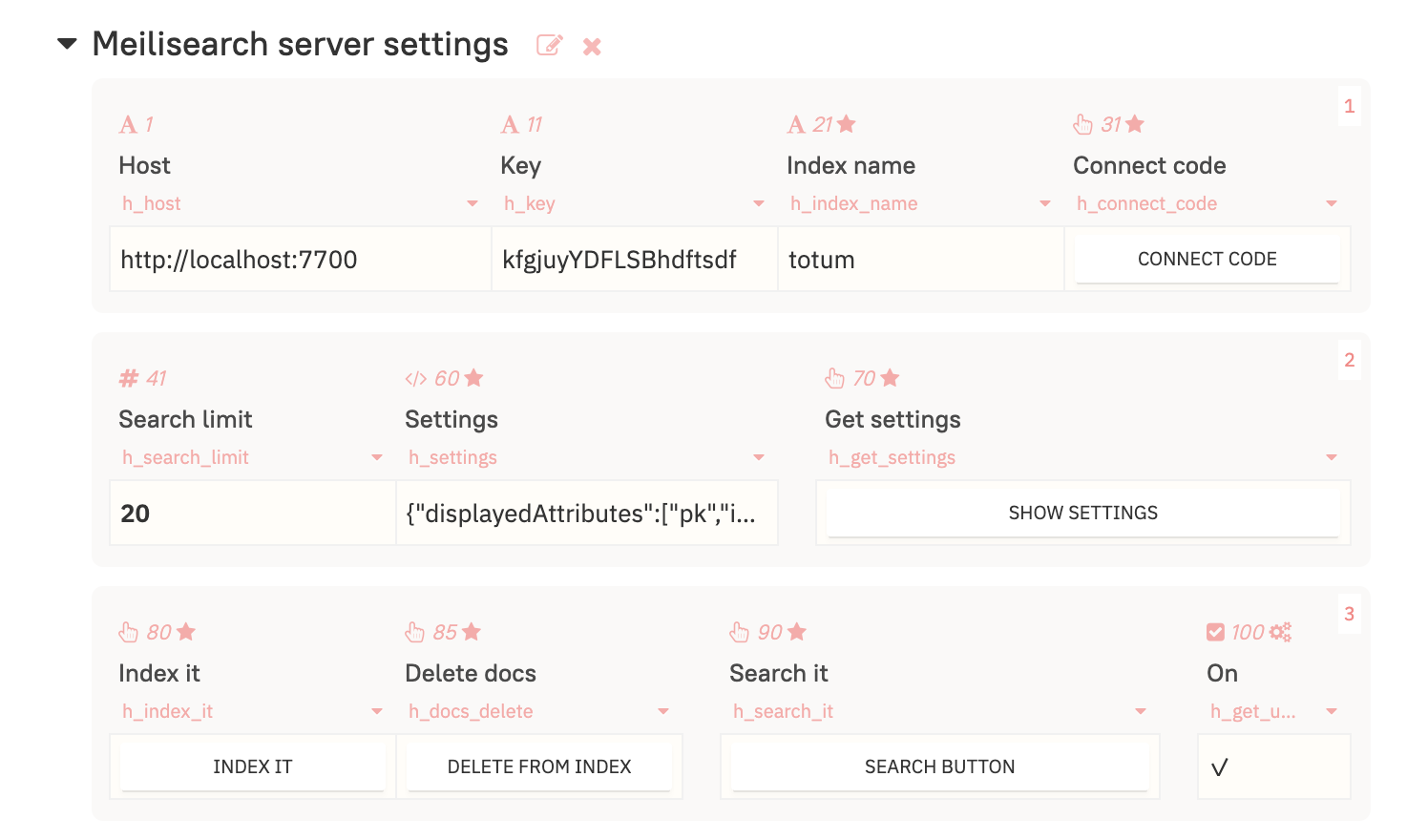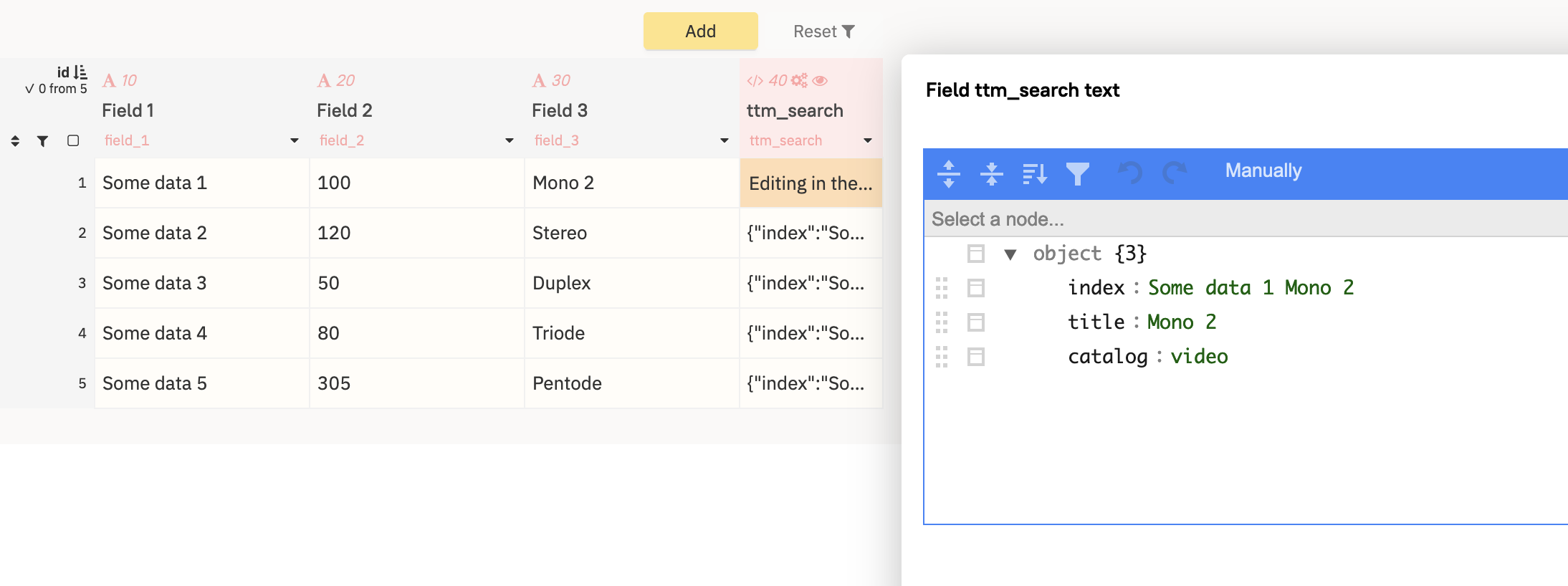Installing meilisearch
Until version V7, meilisearch was installed using an installation script — check for the presence of the
/home/totum/meilifilesfolder.
Below is the installation guide on the same server where Totum is installed:
From the totum user:
su totum
Create a folder:
cd /home/totum && mkdir meilisearch && cd ./meilisearch
Download the binary:
curl -L https://install.meilisearch.com | sh
Generate the key file:
printf "MEILI_MASTERKEY=%s\n" "$(tr -dc 'A-Za-z0-9' < /dev/urandom | head -c24)" > /home/totum/meilisearch/meili_masterkey
Create the service file (one multi-line command):
cat << 'EOF' > /home/totum/meilisearch/meilisearch.service
[Unit]
Description=Meilisearch
After=systemd-user-sessions.service
[Service]
Type=simple
EnvironmentFile=/home/totum/meilisearch/meili_masterkey
WorkingDirectory=/home/totum/meilisearch
ExecStart=/home/totum/meilisearch/meilisearch --no-analytics --db-path ./meilifiles --env production --master-key $MEILI_MASTERKEY
User=totum
Group=totum
Restart=on-failure
[Install]
WantedBy=multi-user.target
EOF
Switch to root:
exit
Connect the service:
ln -s /home/totum/meilisearch/meilisearch.service /etc/systemd/system/meilisearch.service
systemctl daemon-reload
systemctl enable meilisearch.service
systemctl start meilisearch.service
service meilisearch status
Connect the search database to the Totum schema

Fill in h_host — http://localhost:7700 (you can right-click and select Default).
If the host is on a remote server, the address of the remote server should be entered.
In h_key, enter the key created during the installation stage, with which the search database is launched.
The key in the meili_masterkey file:
cat /home/totum/meilisearch/meili_masterkey
In index_name, enter the schema in the search database — a good practice is to make it similar to the Totum schema.
The schema is added to the search database at the moment the value is saved in the field — try to do this only once.
You can check the addition of the schema by clicking on Connect code.
Search limit is 20 by default. If you need to display a different maximum number of search options, enter a number.
We do not recommend setting a large number, as they will not fit on the screen anyway.
To set search settings, fill in settings with the following parameters (this can be done by right-clicking on the field):
{
"displayedAttributes": [
"pk",
"index",
"catalog",
"title",
"text"
],
"searchableAttributes": [
"title",
"index"
],
"attributesForFaceting": [
"catalog",
"table"
]
}
Show settings — shows the current search index (schema) settings.
Index it — allows you to manually pass rows to the search index by specifying table_id + / + row_ids separated by commas.
If the rows were absent in the index, they will be added.
If they were present, they will be updated.
The table must be added to the search tables and have a technical field
ttm_searchin the row part with the correct data format!
Delete from index — allows you to manually delete rows from the index similarly to Index it.
If you pass
table_id/*ALL*, the search index for the entire table will be deleted.
Search — search, the result of which is shown in json.
The
h_get_updatesfield is responsible for displaying the search button in the interface. It is calculated by code based onh_host,h_key,h_index_name,h_settings, but you can set the value manually. For example, disable it until table settings are entered.
Configure search data in the target table
Create a field of type data with name = ttm_search (mandatory!) in the target table. The search will be updated when this field is added (row), changed, and deleted (row). The content of this field is passed to the search database, which must match the format:
{
"index": "data for search",
"title": "title for this index",
"catalog": "catalog name from ttm__search_catalog"
}

For example:
= : rowCreate(field: "index" = str`#field_1 ++ #field_3`; field: "title" = #field_3; field: "catalog" = "video")
The catalog parameter is passed the name of the catalog, which needs to be created in the ttm__search_catalog table.
For a simple table, don't forget to recalculate the rows so that the data in ttm_search is updated, and then check the data structure in a couple of rows.
Add tables to the search

After that, you need to add the table to the row part in ttm__search_settings and fill in the code and buttons parameters.
code— the action code that will be executed when clicking on the search result tile. It is executed from the table row containing the search result and receives the corresponding environment data.buttons— extends possible actions by adding buttons to the search result tile.
To index (add to the search database) the data of the added table, click Index table.
